Three-Dimensional Hydrodynamic and Sediment-Transport Modeling of a Shallow Urban Lake in the Brazilian Amazon
Abstract
1. Introduction
2. Materials and Methods
2.1. Study Area
2.2. Data Acquisition
2.3. Model Description
2.3.1. Heat Flux Model Description
2.3.2. Morphodynamics and Sediment-Transport Module Description
2.3.3. Configuration and Parameterization of Simulation Input Variables
3. Results and Discussion
3.1. Calibration
3.2. Model Validation
3.3. Zonation
3.4. Circulation Patterns of Água Preta Lake
3.5. Temperature Patterns and Stratification
3.6. Transport and Sedimentation of Lake Água Preta
4. Conclusions
Author Contributions
Funding
Data Availability Statement
Acknowledgments
Conflicts of Interest
References
- Esteves, F.A. Fundamentos de Limnologia; Interciência: Rio de Janeiro, Brazil, 1998. [Google Scholar]
- Liu, S.; Ye, Q.; Wu, S.; Stive, M.J.F. Horizontal Circulation Patterns in a Large Shallow Lake: Taihu Lake, China. Water 2018, 10, 792. [Google Scholar] [CrossRef]
- Bailey, M.C.; Hamilton, D.P. Wind Induced Sediment Resuspension: A Lake-Wide Model. Ecol. Model. 1997, 99, 217–228. [Google Scholar] [CrossRef]
- James, R.T.; Martin, J.; Wool, T.; Wang, P.F. A Sediment Resuspension and Water Quality Model of Lake Okeechobee. JAWRA J. Am. Water Resour. Assoc. 1997, 33, 661–678. [Google Scholar] [CrossRef]
- Qin, B.; Zhang, Y.; Zhu, G.; Gao, G. Eutrophication Control of Large Shallow Lakes in China. Sci. Total Environ. 2023, 881, 163494. [Google Scholar] [CrossRef]
- Naselli-Flores, L. Urban Lakes: Ecosystems at Risk, Worthy of the Best Care. In Proceedings of the Taal2007: The 12th World Lake Conference, Jaipur, Rajasthan, India, 28 October–2 November 2007; International Lake Environment Committee: Kusatsu, Japan; pp. 1333–1337. [Google Scholar]
- Zhang, C.; Chen, L. A Review of Wind-Driven Hydrodynamics in Large Shallow Lakes: Importance, Process-Based Modeling and Perspectives. Camb. Prism. Water 2023, 1, e16. [Google Scholar] [CrossRef]
- Scheffer, M.; van Nes, E.H. Shallow Lakes Theory Revisited: Various Alternative Regimes Driven by Climate, Nutrients, Depth and Lake Size. Hydrobiologia 2007, 584, 455–466. [Google Scholar] [CrossRef]
- Chung, E.G.; Bombardelli, F.A.; Schladow, S.G. Sediment Resuspension in a Shallow Lake. Water Resour. Res. 2009, 45, W05422. [Google Scholar] [CrossRef]
- Zhao, J.; Ding, W.; Xu, S.; Ruan, S.; Wang, Y.; Zhu, S. Prediction of Sediment Resuspension in Lake Taihu Using Support Vector Regression Considering Cumulative Effect of Wind Speed. Water Sci. Eng. 2021, 14, 228–236. [Google Scholar] [CrossRef]
- Feldbauer, J.; Mesman, J.P.; Andersen, T.K.; Ladwig, R. Learning from a Large-Scale Calibration Effort of Multiple Lake Temperature Models. Hydrol. Earth Syst. Sci. 2025, 29, 1183–1199. [Google Scholar] [CrossRef]
- Zhao, L.; Li, T.; Przybysz, A.; Liu, H.; Zhang, B.; An, W.; Zhu, C. Effects of Urban Lakes and Neighbouring Green Spaces on Air Temperature and Humidity and Seasonal Variabilities. Sustain. Cities Soc. 2023, 91, 104438. [Google Scholar] [CrossRef]
- Jandaghian, Z.; Colombo, A. The Role of Water Bodies in Climate Regulation: Insights from Recent Studies on Urban Heat Island Mitigation. Buildings 2024, 14, 2945. [Google Scholar] [CrossRef]
- Schirpke, U.; Tasser, E.; Ebner, M.; Tappeiner, U. What can geotagged photographs tell us about cultural ecosystem services of lakes? Ecosyst. Serv. 2021, 51, 101354. [Google Scholar] [CrossRef]
- Koue, J. Modeling the Effects of River Inflow Dynamics on the Deep Layers of Lake Biwa, Japan. Environ. Process. 2023, 10, 62. [Google Scholar] [CrossRef]
- Jiang, M.; Brereton, A.; Beckler, J.; Moore, T.; Brewton, R.A.; Hu, C.; Lapointe, B.E.; McFarland, M.N. Modeling Water Quality and Cyanobacteria Blooms in Lake Okeechobee: I. Model Descriptions, Seasonal Cycles, and Spatial Patterns. Ecol. Model. 2025, 502, 111018. [Google Scholar] [CrossRef]
- Menchén, A.; Espín, Y.; Valiente, N.; Toledo, B.; Álvarez-Ortí, M.; Gómez-Alday, J.J. Distribution of Endocrine Disruptor Chemicals and Bacteria in Saline Pétrola Lake (Albacete, SE Spain) Protected Area Is Strongly Linked to Land Use. Appl. Sci. 2020, 10, 4017. [Google Scholar] [CrossRef]
- Zhang, Z.; Li, J.; Luo, X.; Li, C.; Zhang, L. Urban Lake Spatial Openness and Relationship with Neighboring Land Prices: Exploratory Geovisual Analytics for Essential Policy Insights. Land Use Policy 2020, 92, 104479. [Google Scholar] [CrossRef]
- Cheng, X.; Qu, M.; Hu, Y.; Liu, X.; Mei, Y. Differences in Microbial Communities and Phosphorus Cycles between Rural and Urban Lakes: Based on Glyphosate and AMPA Effects. J. Environ. Manag. 2025, 376, 124577. [Google Scholar] [CrossRef] [PubMed]
- Wen, C.; Zhan, Q.; Zhan, D.; Zhao, H.; Yang, C. Spatiotemporal Evolution of Lakes under Rapid Urbanization: A Case Study in Wuhan, China. Water 2021, 13, 1171. [Google Scholar] [CrossRef]
- Xie, H.; Ma, Y.; Jin, X.; Jia, S.; Zhao, X.; Zhao, X.; Cai, Y.; Xu, J.; Wu, F.; Giesy, J.P. Land Use and River-Lake Connectivity: Biodiversity Determinants of Lake Ecosystems. Environ. Sci. Ecotechnol. 2024, 21, 100434. [Google Scholar] [CrossRef]
- Mishra, J.; Parashar, D.D.; Kumar, D.R. Review of Planning Guidelines for Urban Lakes in India. J. Posit. Sch. Psychol. 2023, 7, 555–562. [Google Scholar]
- Xie, Q.; Ren, L.; Yang, C. Regulation of Water Bodies to Urban Thermal Environment: Evidence from Wuhan, China. Front. Ecol. Evol. 2023, 11, 983567. [Google Scholar] [CrossRef]
- Monteith, J.L.; Unsworth, M.H. Micrometeorology. In Principles of Environmental Physics; Elsevier: Amsterdam, The Netherlands, 2013; pp. 289–320. ISBN 978-0-12-386910-4. [Google Scholar]
- Wang, X.; Cheng, Y. Urban Lake Health Assessment Based on the Synergistic Perspective of Water Environment and Social Service Functions. Glob. Chall. 2024, 8, 2400144. [Google Scholar] [CrossRef]
- Hossu, C.A.; Iojă, I.-C.; Onose, D.A.; Niță, M.R.; Popa, A.-M.; Talabă, O.; Inostroza, L. Ecosystem Services Appreciation of Urban Lakes in Romania. Synergies and Trade-Offs between Multiple Users. Ecosyst. Serv. 2019, 37, 100937. [Google Scholar] [CrossRef]
- IBGE Instituto Brasileiro de Geografia e Estatística (Brazilian Institute of Geography and Statistics) Cidades. Available online: https://cidades.ibge.gov.br/brasil/pa/belem/panorama (accessed on 30 June 2025).
- Wei, G.; Yang, Z.; Liang, C.; Yang, X.; Zhang, S. Urban Lake Scenic Protected Area Zoning Based on Ecological Sensitivity Analysis and Remote Sensing: A Case Study of Chaohu Lake Basin, China. Sustainability 2022, 14, 13155. [Google Scholar] [CrossRef]
- Mishra, M.; Singhal, A.; Srinivas, R. Effect of Urbanization on the Urban Lake Water Quality by Using Water Quality Index (WQI). Mater. Today Proc. 2023, in press. [Google Scholar] [CrossRef]
- Andrade, A.L.C.; Tavares, P.A.; Santos, Y.R.; Brabo, L.D.M.; Ribeiro, H.M.C.; Beltrão, N.E.S. Diagnóstico ambiental dos impactos da proliferação de vegetação macrófita no lago Bolonha na cidade de Belém-PA. Blucher Eng. Proc. 2017, 4, 473–481. [Google Scholar]
- De Oliveira, G.M.T.S.; de Oliveira, E.S.; de Lourdes Souza Santos, M.; de Melo, N.F.A.C.; Krag, M.N. Concentrações de metais pesados nos sedimentos do lago Água Preta (Pará, Brasil). Eng. Sanit. Ambient. 2018, 23, 599–605. [Google Scholar] [CrossRef]
- de Castro, D.C.C.; Rodrigues, R.S.S.; Filho, D.F.F. Surface runoff from drainage area of the lakes Bolonha and Black Water in Belém and Ananindeua, Pará. Res. Soc. Dev. 2020, 9, e38932373. [Google Scholar] [CrossRef]
- Kiefer, I.; Odermatt, D.; Anneville, O.; Wüest, A.; Bouffard, D. Application of Remote Sensing for the Optimization of In-Situ Sampling for Monitoring of Phytoplankton Abundance in a Large Lake. Sci. Total Environ. 2015, 527–528, 493–506. [Google Scholar] [CrossRef] [PubMed]
- Baracchini, T.; Chu, P.Y.; Šukys, J.; Lieberherr, G.; Wunderle, S.; Wüest, A.; Bouffard, D. Data Assimilation of in Situ and Satellite Remote Sensing Data to 3D Hydrodynamic Lake Models: A Case Study Using Delft3D-FLOW v4.03 and OpenDA v2.4. Geosci. Model Dev. 2020, 13, 1267–1284. [Google Scholar] [CrossRef]
- da Silva Holanda, P.; Blanco, C.J.C.; de Almeida Cruz, D.O.; Lopes, D.F.; Barp, A.R.B.; Secretan, Y. Hydrodynamic Modeling and Morphological Analysis of Lake Água Preta: One of the Water Sources of Belém-PA-Brazil. J. Braz. Soc. Mech. Sci. Eng. 2011, 33, 117–124. [Google Scholar] [CrossRef]
- Santos, M.L.S.; de Lima Saraiva, A.L.; Pereira, J.A.R.; de Souza Marcio, P.F.R.; da Silva, A.C. Hydrodynamic Modeling of a Reservoir Used to Supply Water to Belem (Lake Agua Preta, Para, Brazil). Acta Sci. Technol. 2015, 37, 353. [Google Scholar] [CrossRef]
- Liu, W.-C.; Liu, H.-M.; Yam, R.S.-W. A Three-Dimensional Coupled Hydrodynamic-Ecological Modeling to Assess the Planktonic Biomass in a Subalpine Lake. Sustainability 2021, 13, 12377. [Google Scholar] [CrossRef]
- Secretaria de Estado de Meio Ambiente. Revisão do Plano de Manejo do Parque Estadual do Utinga; Governo do Pará: Belém, Brazil, 2013.
- Thomaz, S.M. Fatores ecológicos associados à colonização e ao desenvolvimento de macrófitas aquáticas e desafios de manejo. Planta Daninha 2002, 20, 21–33. [Google Scholar] [CrossRef]
- De Oliveira, P.A.; Blanco, C.J.C.; Mesquita, A.L.A.; Lopes, D.F.; Filho, M.D.C.F. Estimation of Suspended Sediment Concentration in Guamá River in the Amazon Region. Environ. Monit. Assess. 2021, 193, 79. [Google Scholar] [CrossRef] [PubMed]
- Bastos, T.X.; Pacheco, N.A.; Nechet, D. Aspectos Climáticos de Belém nos Últimos Cem Anos; Ministério da Agricultura e Pecuária: Belém, Brazil, 2002.
- SEGEP–Secretaria Municipal de Coordenação Geral do Planejamento e Gestão. Anuário Estatístico do Município de Belém, v. 16; SEGEP: Belém, Brazil, 2012.
- De Queiroz Xavier Brasil, N.M.; Neto, A.B.B.; Paumgartten, A.É.A.; de Queiroz Xavier Silveira, J.M.; da Silva, A.A. Análise multitemporal da cobertura do solo do Parque Estadual do Utinga, Belém, Pará/Multitemporal analysis of the soil coverage of the Utinga State Park, Belém, Pará. Braz. J. Dev. 2021, 7, 36109–36118. [Google Scholar] [CrossRef]
- Herb, W.R.; Stefan, H.G. Temperature Stratification and Mixing Dynamics in a Shallow Lake with Submersed Macrophytes. Lake Reserv. Manag. 2004, 20, 296–308. [Google Scholar] [CrossRef]
- Jin, K.-R.; Ji, Z.-G. Application and Validation of Three-Dimensional Model in a Shallow Lake. J. Waterw. Port Coast. Ocean Eng. 2005, 131, 213–225. [Google Scholar] [CrossRef]
- Soulignac, F.; Vinçon-Leite, B.; Lemaire, B.J.; Scarati Martins, J.R.; Bonhomme, C.; Dubois, P.; Mezemate, Y.; Tchiguirinskaia, I.; Schertzer, D.; Tassin, B. Performance Assessment of a 3D Hydrodynamic Model Using High Temporal Resolution Measurements in a Shallow Urban Lake. Environ. Model. Assess. 2017, 22, 309–322. [Google Scholar] [CrossRef]
- Deltares. Delft3D-FLOW, User Manual, version 4.05; Deltares: Delft, The Netherlands, 2024; 753p. [Google Scholar]
- Baracchini, T.; Hummel, S.; Verlaan, M.; Cimatoribus, A.; Wüest, A.; Bouffard, D. An Automated Calibration Framework and Open Source Tools for 3D Lake Hydrodynamic Models. Environ. Model. Softw. 2020, 134, 104787. [Google Scholar] [CrossRef]
- Liu, S.; Ye, Q.; Wu, S.; Stive, M.J.F. Wind Effects on the Water Age in a Large Shallow Lake. Water 2020, 12, 1246. [Google Scholar] [CrossRef]
- Hassan, A.; Ismail, S.; Elmoustafa, A.; Khalaf, S. Evaluating Evaporation Rate from High Aswan Dam Reservoir Using RS and GIS Techniques. Egypt. J. Remote Sens. Space Sci. 2018, 21, 285–293. [Google Scholar] [CrossRef]
- Lesser, G.R.; Roelvink, J.A.; van Kester, J.A.T.M.; Stelling, G.S. Development and Validation of a Three-Dimensional Morphological Model. Coast. Eng. 2004, 51, 883–915. [Google Scholar] [CrossRef]
- Roy, B.; Haider, M.R.; Yunus, A. A Study on Hydrodynamic and Morphological Behavior of Padma River Using Delft3d Model. In Proceedings of the 3rd International Conference on Civil Engineering for Sustainable Development, KUET, Khulna, Bangladesh, 12–14 February 2016; Department of Civil Engineering, KUET: Khulna, Bangladesh, 2016; pp. 561–572. [Google Scholar]
- Duka, M.A.; Monterey, M.L.E.; Casim, N.C.I.; Andres, J.H.R.; Yokoyama, K. Identifying Challenges to 3D Hydrodynamic Modeling for a Small, Stratified Tropical Lake in the Philippines. Water 2024, 16, 561. [Google Scholar] [CrossRef]
- Allen, R.; Pereira, L.; Raes, D.; Smith, M. Crop Evapotranspiration—Guidelines for Computing Crop Requirements—FAO Irrigation and Drainage Paper 56; FAO: Rome, Italy, 1998; Volume 285, pp. 19–40. [Google Scholar]
- Lick, W. Numerical modeling of lake currents. Annual Review of Earth and Planetary Sciences. Annu. Rev. Earth Planet. Sci. 1976, 4, 49–74. [Google Scholar] [CrossRef]
- Resio, D.; Vincent, C. Estimation of Winds over the Great Lakes. J. Waterw. Harbour. Coast. Eng. Div. ASCE 1977, 102, 263–282. [Google Scholar] [CrossRef]
- Chen, F.; Zhang, C.; Brett, M.T.; Nielsen, J.M. The Importance of the Wind-Drag Coefficient Parameterization for Hydrodynamic Modeling of a Large Shallow Lake. Ecol. Inform. 2020, 59, 101106. [Google Scholar] [CrossRef]
- Pires, P.V.B.; de Sousa, E.B.; Gomes, A.L.; Cunha, C.J.S.; da Costa Tavares, V.B.; Pinheiro, S.C.C.; Carneiro, B.S.; de Melo, N.F.A.C. Effect of Seasonality and Estuarine Waters on the Phytoplankton of the Guamá River (Belém, Amazon, Brazil). An. Acad. Bras. Ciênc. 2024, 96, e20220413. [Google Scholar] [CrossRef]
- Arcement, G.J.; Schneider, V.R. Guide for Selecting Manning’s Roughness Coefficients for Natural Channels and Flood Plains; U.S.G.P.O.: Washington, DC, USA, 1989.
- Phillips, J.V.; Tadayon, S. Selection of Manning’s Roughness Coefficient for Natural and Constructed Vegetated and Non-Vegetated Channels, and Vegetation Maintenance Plan Guidelines for Vegetated Channels in Central Arizona; Scientific Investigations Report; USGS Publications Warehouse: Reston, VA, USA, 2006. [CrossRef]
- Wang, M.; Strokal, M.; Burek, P.; Kroeze, C.; Ma, L.; Janssen, A.B.G. Excess Nutrient Loads to Lake Taihu: Opportunities for Nutrient Reduction. Sci. Total Environ. 2019, 664, 865–873. [Google Scholar] [CrossRef] [PubMed]
- Gasca-Ortiz, T.; Pantoja, D.A.; Filonov, A.; Domínguez-Mota, F.; Alcocer, J. Numerical and Observational Analysis of the Hydro-Dynamical Variability in a Small Lake: The Case of Lake Zirahuén, México. Water 2020, 12, 1658. [Google Scholar] [CrossRef]
- Rasmussen, H.; Badr, H.M. Validation of Numerical Models of the Unsteady Flow in Lakes. Appl. Math. Model. 1979, 3, 416–420. [Google Scholar] [CrossRef]
- Tundisi, J.G.; Tundisi, T.M. Limnologia; Oficina de Textos: São Paulo, Brazil, 2008. [Google Scholar]
- Torma, P.; Wu, C.H. Temperature and Circulation Dynamics in a Small and Shallow Lake: Effects of Weak Stratification and Littoral Submerged Macrophytes. Water 2019, 11, 128. [Google Scholar] [CrossRef]
- Wüest, A.; Lorke, A. Small-Scale Hydrodynamics in Lakes. Annu. Rev. Fluid Mech. 2003, 35, 373–412. [Google Scholar] [CrossRef]
- Jin, H.; van Leeuwen, C.H.A.; Van de Waal, D.B.; Bakker, E.S. Impacts of Sediment Resuspension on Phytoplankton Biomass Production and Trophic Transfer: Implications for Shallow Lake Restoration. Sci. Total Environ. 2022, 808, 152156. [Google Scholar] [CrossRef]
- Sodré, S.D.S.V. Hidroquímica dos Lagos Bolonha e Água Preta Mananciais de Belém-PA. Master’s Dissertation, Universidade Federal do Pará, Belém, Brazil, 2007. (In Portuguese). [Google Scholar]
- de Aviz, M.D.; de Souza, A.J.N.; Coelho, A.O.; de Farias, F.F.; Mendes, J.O.O.; de Oliveira, T.D.T.S.; Pereira, J.A.R.; de Lourdes Souza Santos, M. Sensoriamento remoto como ferramenta da estimativa do estado trófico de lago urbano na Amazônia (Belém, PA). Rev. Ibero-Am. Ciências Ambient. 2022, 13, 95–107. [Google Scholar] [CrossRef]
- Carvalho, M.C. Investigação do Registro Histórico da Composição Isotópica do Chumbo e da Concentração de Metais Pesados em Testemunhos de Sedimentos no Lago Água Preta, Região metropolitana de Belém-Pará. Matser’s Dissertation, Mestrado em Geoquímica e Petrologia, Centro de Geociências, Universidade Federal do Pará, Belém, Brazil, 2001. (In Portuguese). [Google Scholar]
- Li, B.; Chen, D.; Lu, J.; Liu, S.; Wu, J.; Gan, L.; Yang, X.; He, X.; He, H.; Yu, J.; et al. Restoring Turbid Eutrophic Shallow Lakes to a Clear-Water State by Combined Biomanipulation and Chemical Treatment: A 4-Hectare in-Situ Experiment in Subtropical China. J. Environ. Manag. 2025, 380, 125061. [Google Scholar] [CrossRef]
- Scheffer, M.; Hosper, S.H.; Meijer, M.-L.; Moss, B.; Jeppesen, E. Alternative Equilibria in Shallow Lakes. Trends Ecol. Evol. 1993, 8, 275–279. [Google Scholar] [CrossRef] [PubMed]
- Hilt, S.; Brothers, S.; Jeppesen, E.; Veraart, A.J.; Kosten, S. Translating Regime Shifts in Shallow Lakes into Changes in Ecosystem Functions and Services. BioScience 2017, 67, 928–936. [Google Scholar] [CrossRef]
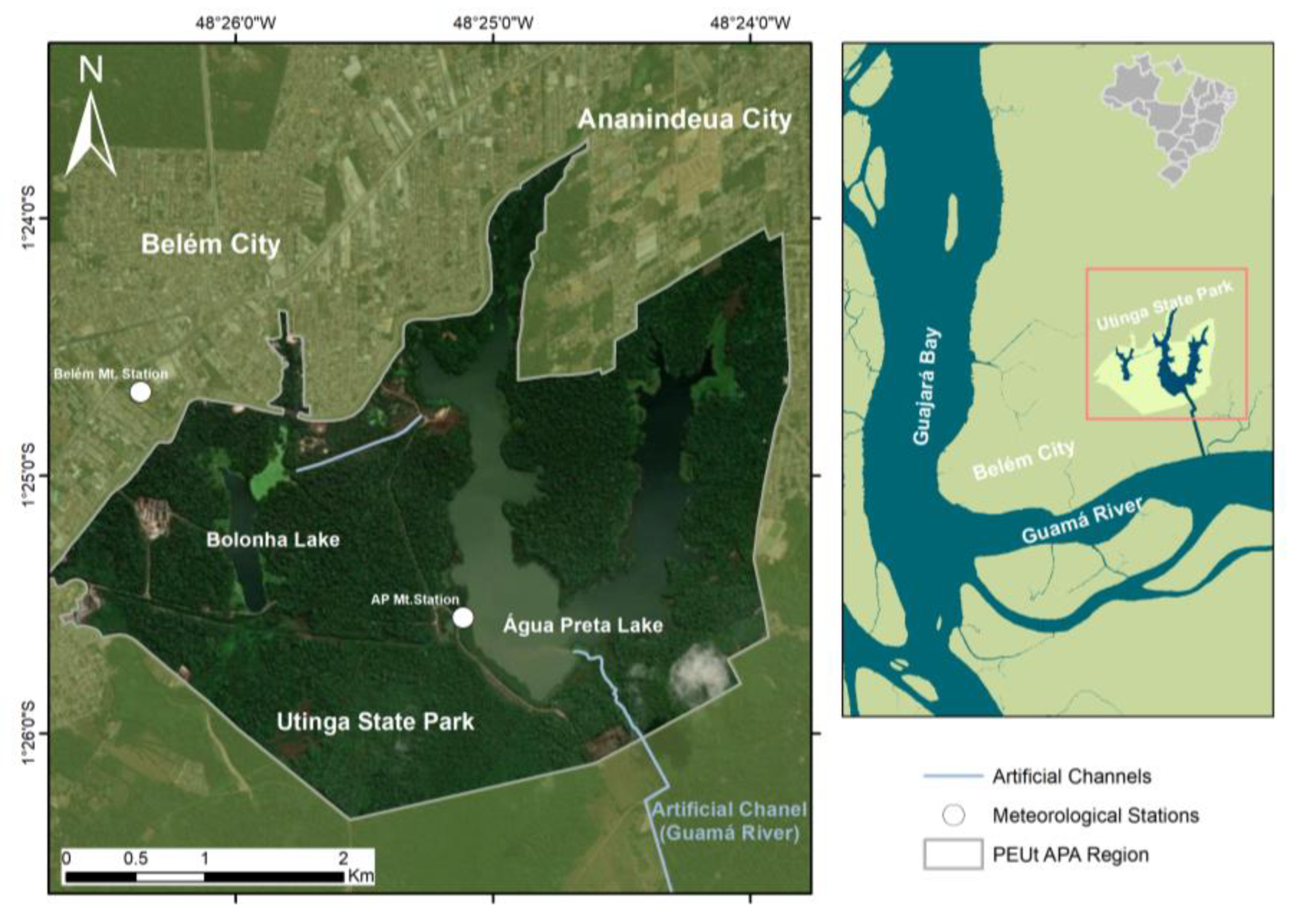
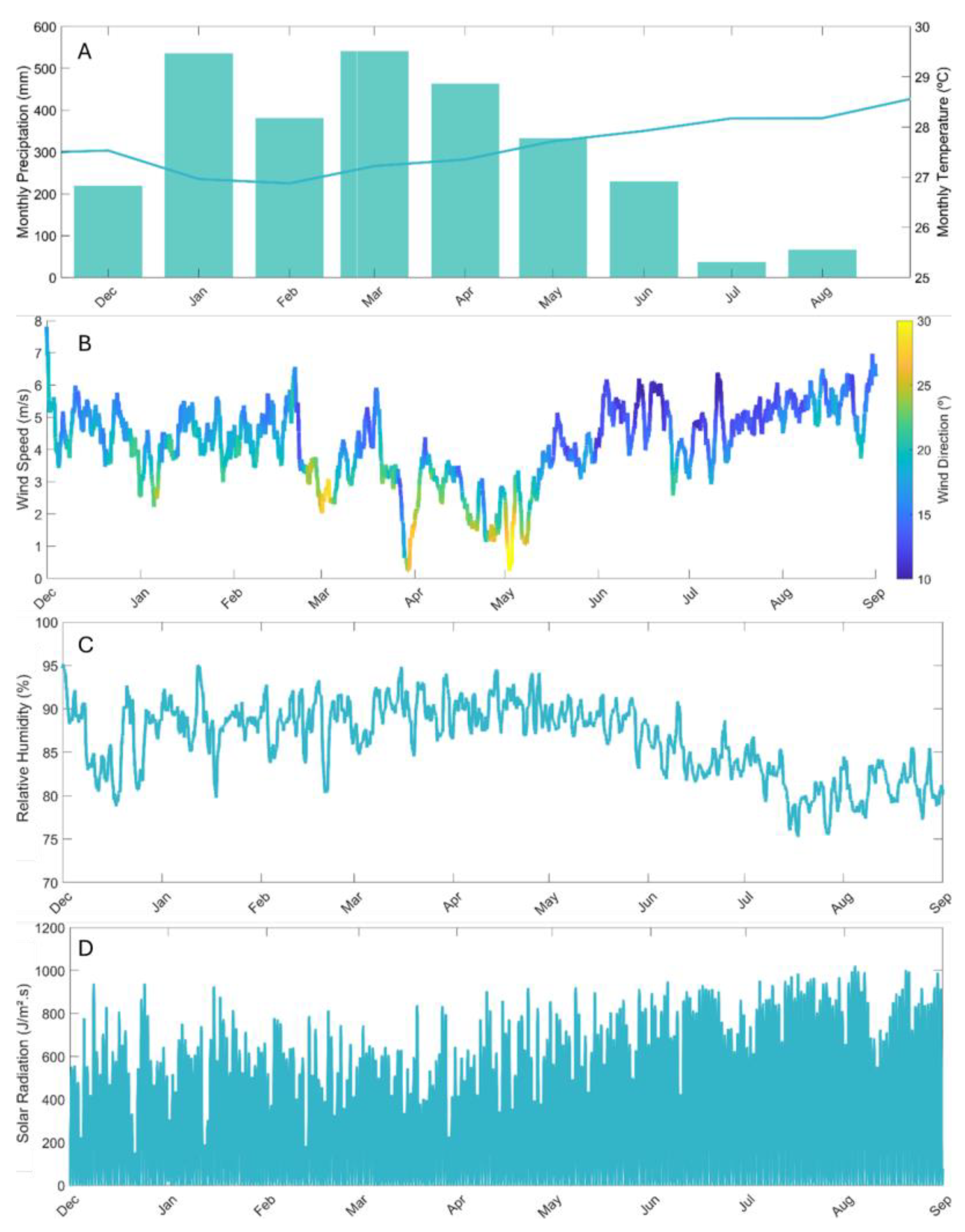

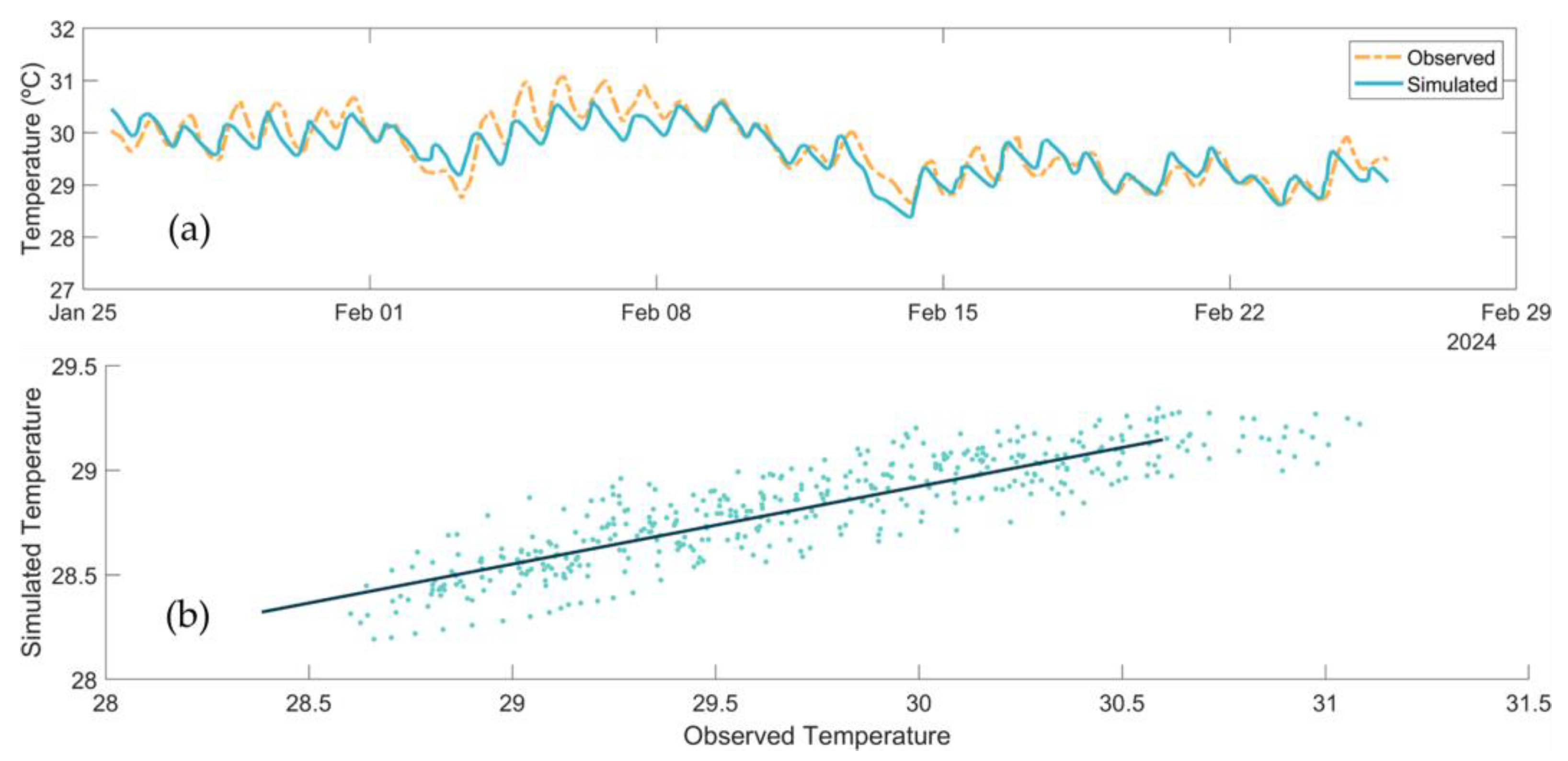

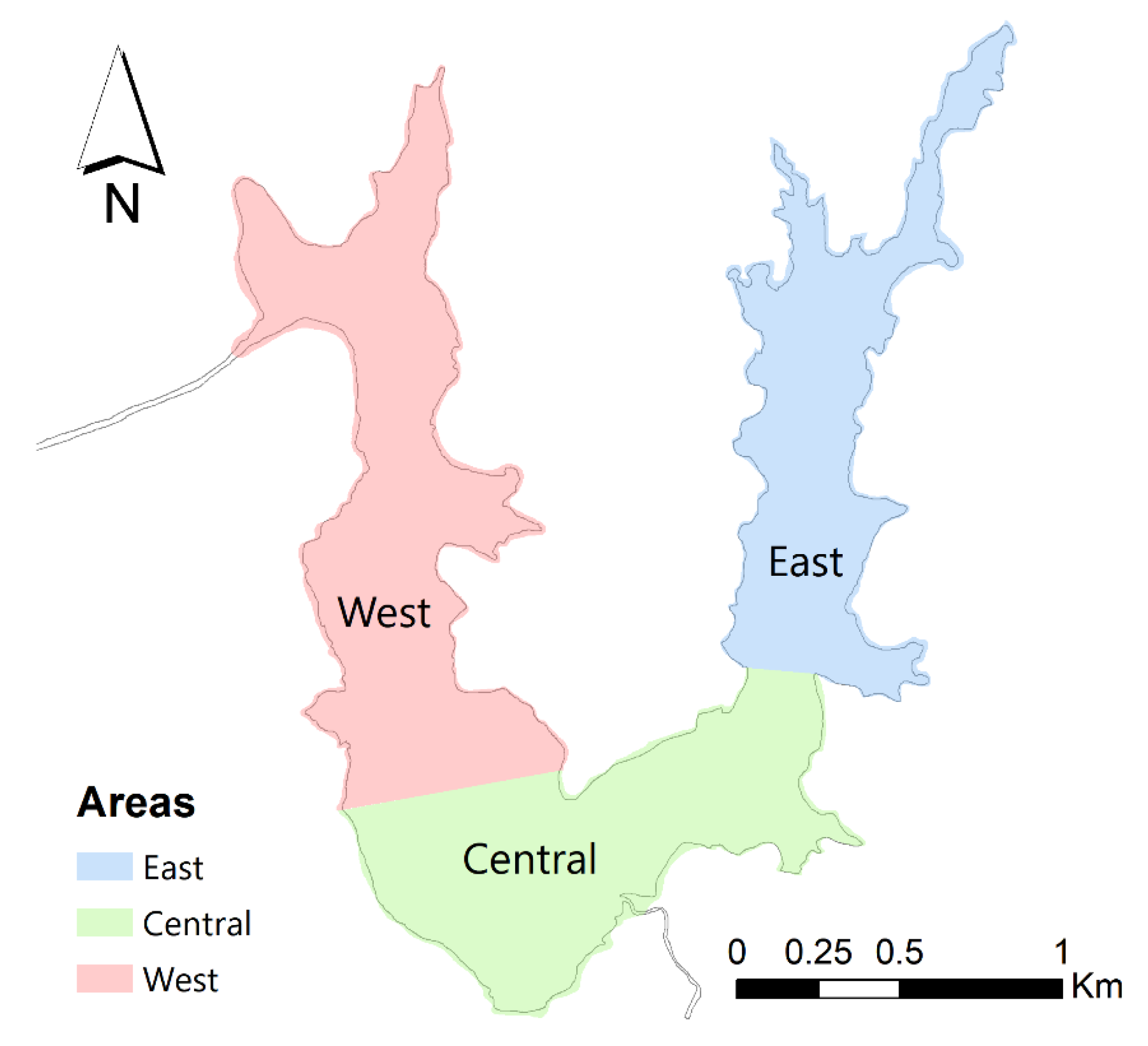

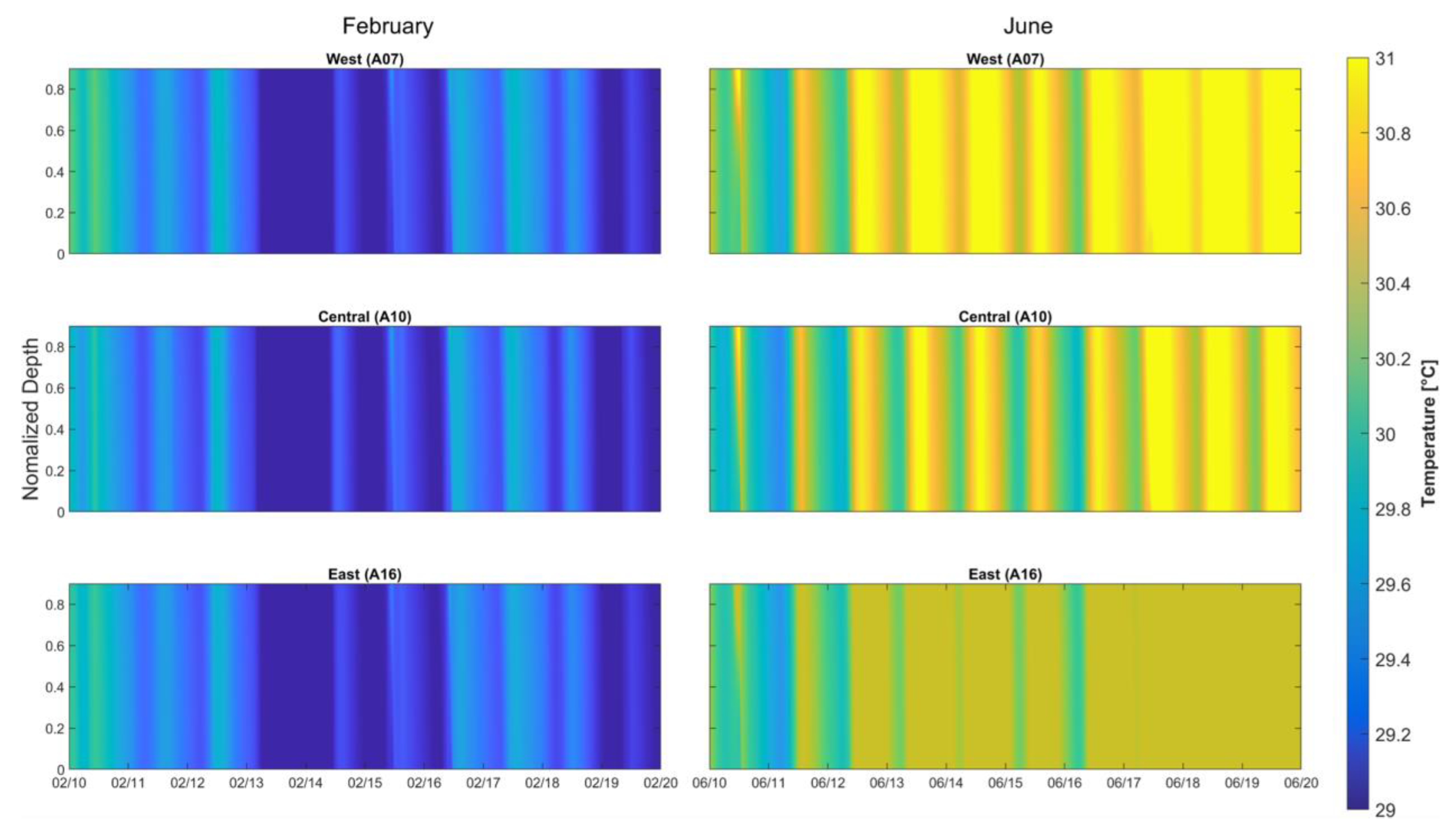
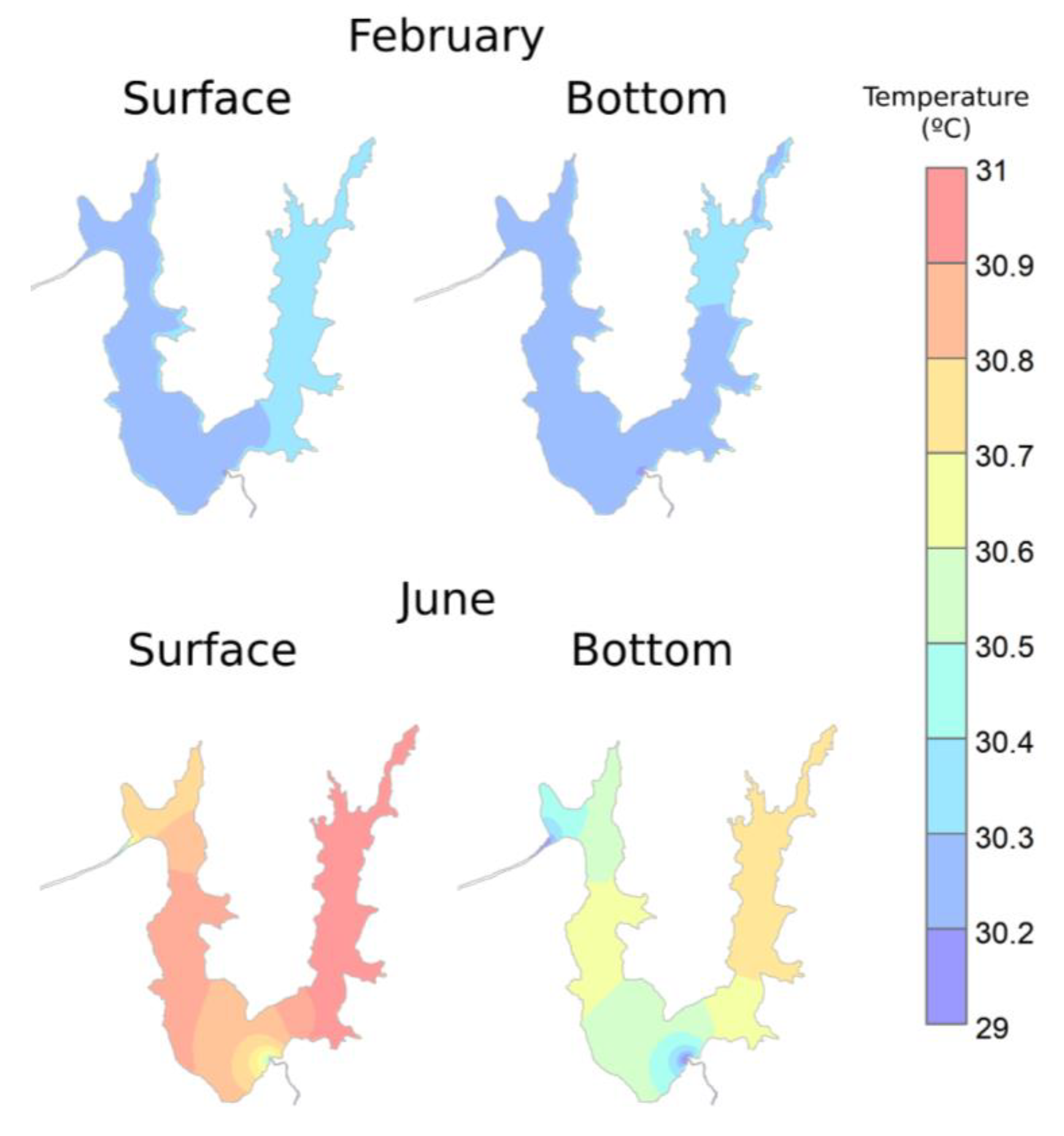

| Monitoring Period | Discharge (m3/s) | Monitoring Period | Discharge (m3/s) |
|---|---|---|---|
| November 2023 | 20 | May 2024 | 16 |
| December 2023 | 19 | June 2024 | 18 |
| January 2024 | 16 | July 2024 | 19 |
| February 2024 | 14 | August 2024 | 20 |
| March 2024 | 14 | September 2024 | 20 |
| April 2024 | 14 | October 2024 | 19 |
| Region | Manning Roughness Value |
|---|---|
| Region dominated by macrophytes | 0.030 |
| Sandy sediment-predominance region | 0.025 |
| Sandy-silty sediment region | 0.018 |
| Silty sediment region | 0.016 |
| ρ | RMSE (°C) | R2 | MAE (°C) | |||||||||||||
|---|---|---|---|---|---|---|---|---|---|---|---|---|---|---|---|---|
| Sites | Dec | Feb | Jun | Aug | Dec | Feb | Jun | Aug | Dec | Feb | Jun | Aug | Dec | Feb | Jun | Aug |
| A01 * | −0.05 * | 0.85 | 0.82 | 0.96 | 0.78 | 0.78 | 0.87 | 0.34 | 0.00 | 0.72 | 0.68 | 0.91 | 0.98 | 1.31 | 1.16 | 0.39 |
| A02 | 0.95 | 0.85 | 0.94 | 0.83 | 0.80 | 0.26 | 0.42 | 0.26 | 0.91 | 0.74 | 0.89 | 0.69 | 0.91 | 0.43 | 0.64 | 0.28 |
| A03 | −0.29 | 0.86 | 0.99 | 0.96 | 0.24 | 0.41 | 0.57 | 0.37 | 0.08 | 0.73 | 0.99 | 0.91 | 0.27 | 0.70 | 0.75 | 0.50 |
| A04 | 0.91 | 0.79 | 0.41 | 0.36 | 0.25 | 0.39 | 0.69 | 0.41 | 0.83 | 0.63 | 0.17 | 0.13 | 0.33 | 0.51 | 1.19 | 0.45 |
| A05 | 0.98 | 0.86 | 0.97 | 0.47 | 0.24 | 0.46 | 0.43 | 0.25 | 0.96 | 0.74 | 0.94 | 0.22 | 0.29 | 0.49 | 0.69 | 0.35 |
| A06 | 0.92 | 0.86 | 0.86 | 0.69 | 0.40 | 0.41 | 0.62 | 0.51 | 0.84 | 0.74 | 0.74 | 0.48 | 0.56 | 0.46 | 0.97 | 0.63 |
| A07 | 0.90 | 0.91 | 0.84 | 0.89 | 0.38 | 0.60 | 0.50 | 0.55 | 0.82 | 0.82 | 0.70 | 0.80 | 0.47 | 0.72 | 0.97 | 0.91 |
| A08 | 0.95 | 0.96 | 0.86 | 0.91 | 0.55 | 0.66 | 0.39 | 0.47 | 0.90 | 0.91 | 0.74 | 0.83 | 0.65 | 0.71 | 0.69 | 0.62 |
| A09 * | 0.73 | 0.69 | 0.97 | −0.30 * | 0.52 | 0.75 | 0.19 | 0.32 | 0.53 | 0.48 | 0.93 | 0.09 | 0.56 | 0.91 | 0.30 | 0.41 |
| A10 | 0.97 | 0.99 | 1.00 | 0.93 | 0.37 | 0.63 | 0.59 | 0.46 | 0.93 | 0.97 | 0.99 | 0.86 | 0.48 | 0.68 | 0.82 | 0.75 |
| A11 * | 0.95 | 0.31 | −0.65 * | 0.94 | 0.50 | 0.52 | 0.08 | 0.56 | 0.90 | 0.10 | 0.42 | 0.89 | 0.62 | 0.68 | 0.12 | 0.72 |
| A12 | 0.94 | 0.99 | 0.94 | 0.86 | 0.25 | 0.81 | 0.26 | 0.18 | 0.87 | 0.98 | 0.88 | 0.73 | 0.38 | 0.87 | 0.43 | 0.24 |
| A13 | 0.94 | 0.95 | 0.91 | 0.98 | 0.35 | 0.67 | 0.40 | 0.14 | 0.88 | 0.90 | 0.82 | 0.95 | 0.72 | 0.75 | 0.60 | 0.24 |
| A14 | 0.84 | 0.88 | 0.80 | 0.98 | 0.21 | 0.50 | 0.30 | 0.48 | 0.70 | 0.77 | 0.63 | 0.97 | 0.34 | 0.71 | 0.56 | 0.72 |
| A15 | 0.98 | 0.87 | 0.92 | 0.67 | 0.35 | 0.51 | 0.44 | 0.29 | 0.96 | 0.76 | 0.84 | 0.45 | 0.64 | 0.61 | 0.65 | 0.50 |
| A16 | 0.87 | 0.88 | 0.88 | 0.90 | 0.43 | 0.57 | 0.49 | 0.31 | 0.75 | 0.78 | 0.77 | 0.82 | 0.68 | 0.94 | 0.73 | 0.53 |
| A17 * | 0.99 | 0.92 | −0.19 * | 0.95 | 0.18 | 0.10 | 0.87 | 0.56 | 0.97 | 0.85 | 0.04 | 0.90 | 0.33 | 0.18 | 2.04 | 0.83 |
| A18 | 0.96 | 0.55 | 0.89 | 0.89 | 0.56 | 0.77 | 0.44 | 0.20 | 0.93 | 0.30 | 0.80 | 0.80 | 0.96 | 1.40 | 0.63 | 0.41 |
| A19 | 0.56 | 0.65 | 0.99 | 0.98 | 0.74 | 0.62 | 0.53 | 0.93 | 0.32 | 0.42 | 0.97 | 0.96 | 1.07 | 1.16 | 0.60 | 1.34 |
Disclaimer/Publisher’s Note: The statements, opinions and data contained in all publications are solely those of the individual author(s) and contributor(s) and not of MDPI and/or the editor(s). MDPI and/or the editor(s) disclaim responsibility for any injury to people or property resulting from any ideas, methods, instructions or products referred to in the content. |
© 2025 by the authors. Licensee MDPI, Basel, Switzerland. This article is an open access article distributed under the terms and conditions of the Creative Commons Attribution (CC BY) license (https://creativecommons.org/licenses/by/4.0/).
Share and Cite
Callado, M.A.V.; Barros Queiroz, A.H.; Rollnic, M. Three-Dimensional Hydrodynamic and Sediment-Transport Modeling of a Shallow Urban Lake in the Brazilian Amazon. Water 2025, 17, 2444. https://doi.org/10.3390/w17162444
Callado MAV, Barros Queiroz AH, Rollnic M. Three-Dimensional Hydrodynamic and Sediment-Transport Modeling of a Shallow Urban Lake in the Brazilian Amazon. Water. 2025; 17(16):2444. https://doi.org/10.3390/w17162444
Chicago/Turabian StyleCallado, Marco Antônio Vieira, Ana Hilza Barros Queiroz, and Marcelo Rollnic. 2025. "Three-Dimensional Hydrodynamic and Sediment-Transport Modeling of a Shallow Urban Lake in the Brazilian Amazon" Water 17, no. 16: 2444. https://doi.org/10.3390/w17162444
APA StyleCallado, M. A. V., Barros Queiroz, A. H., & Rollnic, M. (2025). Three-Dimensional Hydrodynamic and Sediment-Transport Modeling of a Shallow Urban Lake in the Brazilian Amazon. Water, 17(16), 2444. https://doi.org/10.3390/w17162444








